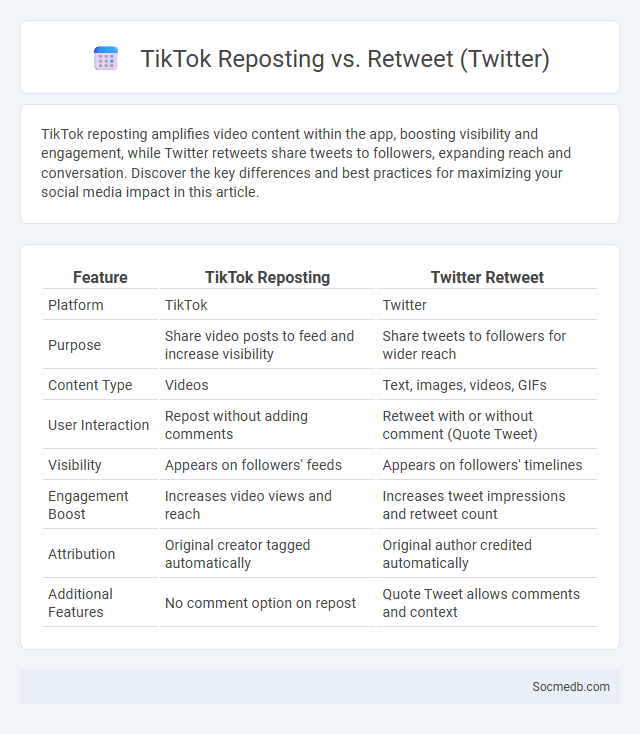
Photo illustration: TikTok Reposting vs Retweet (Twitter)
TikTok reposting amplifies video content within the app, boosting visibility and engagement, while Twitter retweets share tweets to followers, expanding reach and conversation. Discover the key differences and best practices for maximizing your social media impact in this article.
Table of Comparison
| Feature | TikTok Reposting | Twitter Retweet |
|---|---|---|
| Platform | TikTok | |
| Purpose | Share video posts to feed and increase visibility | Share tweets to followers for wider reach |
| Content Type | Videos | Text, images, videos, GIFs |
| User Interaction | Repost without adding comments | Retweet with or without comment (Quote Tweet) |
| Visibility | Appears on followers' feeds | Appears on followers' timelines |
| Engagement Boost | Increases video views and reach | Increases tweet impressions and retweet count |
| Attribution | Original creator tagged automatically | Original author credited automatically |
| Additional Features | No comment option on repost | Quote Tweet allows comments and context |
Understanding TikTok Reposting: A Brief Overview
TikTok reposting enables users to share existing videos on their own profiles, amplifying content reach and engagement. This feature supports viral trends by allowing diverse audiences to interact with popular clips, thus boosting algorithmic visibility. Understanding TikTok reposting is crucial for marketers aiming to maximize brand exposure and user interaction.
How Retweeting Works on Twitter
Retweeting on Twitter allows users to share another user's tweet with their own followers, amplifying the original message's reach and engagement. When a tweet is retweeted, it appears on the retweeter's timeline with a direct link to the source, preserving the original content and context. This feature facilitates viral content distribution and helps users participate in trending conversations by quickly spreading information across the Twitter network.
Comparing TikTok Reposting and Twitter Retweet
TikTok reposting allows users to share short-form video content directly to their profiles, creating personalized streams that enhance content discovery through algorithm-driven recommendations. Twitter retweeting amplifies tweets by redistributing text-based content to followers' timelines, fostering real-time conversations and rapid information dissemination. While TikTok reposting emphasizes visual engagement and trends, Twitter retweets prioritize immediate sharing and widespread visibility of opinions or news.
User Engagement: TikTok vs Twitter
User engagement on TikTok significantly outpaces Twitter, driven by TikTok's algorithm that promotes short, immersive videos, resulting in higher average watch times and interaction rates. Twitter excels in real-time conversations and trending topics, making it ideal for timely updates and direct user communication but with lower content consumption per session. Your brand can leverage TikTok for viral content creation and deeper engagement while using Twitter to participate in public discourse and boost visibility.
Content Reach and Virality Across Platforms
Maximizing content reach and virality across social media platforms hinges on understanding each platform's unique algorithms and audience behavior. High engagement rates, including shares and comments, significantly boost organic reach, helping your posts gain traction beyond your immediate followers. Tailoring content to platform-specific formats and trends enhances visibility, driving exponential spread and audience growth.
Algorithm Impact: TikTok Repost vs Twitter Retweet
TikTok's algorithm prioritizes video reposts by amplifying content based on user interactions, boosting visibility in For You feeds and increasing engagement metrics such as views and shares. In contrast, Twitter's retweet mechanism primarily redistributes tweets within followers' timelines without algorithmic weight on traditional retweets, focusing instead on likes and replies to influence trending status. Understanding these algorithmic distinctions empowers your social media strategy to maximize reach on TikTok by leveraging reposts, while on Twitter, fostering direct interactions remains key to content amplification.
Privacy and Control: Who Sees Your Shares?
Privacy settings on social media platforms determine who can view your shared content, allowing users to customize audiences from public to friends or specific groups. Robust privacy controls enable individuals to limit access to personal information, reducing risks of data breaches or unwanted exposure. Understanding and regularly updating these settings is crucial for maintaining digital privacy and controlling the visibility of your online interactions.
Creative Expression: TikTok Reposts vs Twitter Retweets
Creative expression on TikTok thrives through reposts that emphasize visual storytelling, sound integration, and trends driven by algorithmic personalization. Twitter retweets prioritize textual amplification and real-time dialogue, allowing Your message to reach broader audiences with concise opinions or updates. Understanding these platform-specific dynamics enhances the impact of your social media strategy.
Brand and Influencer Strategies for Each Platform
Effective brand and influencer strategies vary significantly across social media platforms, with Instagram emphasizing visually compelling content and influencer collaborations that drive engagement through Stories and Reels. On TikTok, brands achieve success by leveraging authentic, short-form videos paired with micro-influencers who resonate with niche audiences, fostering viral trends and organic reach. LinkedIn strategies focus on thought leadership and professional influencers to build brand authority through targeted content and network-driven engagement.
The Future of Content Sharing on Social Media
The future of content sharing on social media revolves around immersive experiences powered by augmented reality (AR) and virtual reality (VR), which will transform how users engage with digital content. Advanced AI algorithms will personalize your feeds by predicting and delivering hyper-relevant content that aligns with your interests and behaviors. Decentralized platforms using blockchain technology are set to empower content creators with greater control over ownership, monetization, and data privacy.
 socmedb.com
socmedb.com